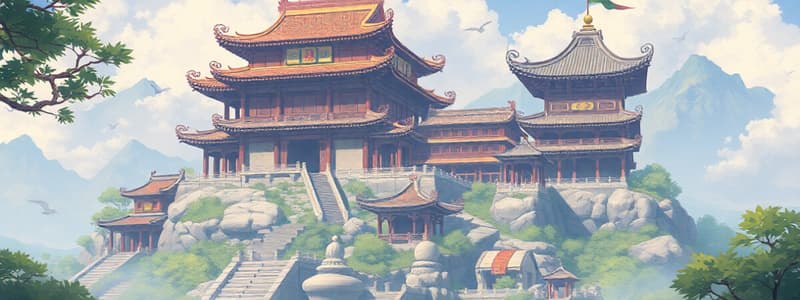Podcast
Questions and Answers
What percentage of the population in China is made up of Han Chinese people?
What percentage of the population in China is made up of Han Chinese people?
- 85%
- 75%
- 92% (correct)
- 95%
Which of the following rivers is NOT mentioned as one of China's major rivers?
Which of the following rivers is NOT mentioned as one of China's major rivers?
- Amazon River (correct)
- Yellow River
- Pearl River
- Yangtze River
Which lake region is NOT listed among the five major lake regions in China?
Which lake region is NOT listed among the five major lake regions in China?
- The Qinghai-Xizang Lake Region
- The Eastern Lake Region
- The Northern Lake Region
- The Southeastern Lake Region (correct)
What is considered the most important energy source for China?
What is considered the most important energy source for China?
Which non-Chinese minority group is NOT mentioned in the provided content?
Which non-Chinese minority group is NOT mentioned in the provided content?
Since when has China experienced tremendous economic growth?
Since when has China experienced tremendous economic growth?
What role does the Chinese Communist Party play in the government?
What role does the Chinese Communist Party play in the government?
Which mineral does China rank first in producing?
Which mineral does China rank first in producing?
What is the primary role of rivers in India?
What is the primary role of rivers in India?
What period did the Indus Valley civilization flourish?
What period did the Indus Valley civilization flourish?
Which city has the highest population in India as of 2006?
Which city has the highest population in India as of 2006?
What percentage of the Indonesian population is primarily engaged in agriculture?
What percentage of the Indonesian population is primarily engaged in agriculture?
What percentage of India's population is Islam, making it the second-most practiced religion?
What percentage of India's population is Islam, making it the second-most practiced religion?
Which of the following religions has the smallest percentage of followers in Indonesia?
Which of the following religions has the smallest percentage of followers in Indonesia?
What is the highest executive authority in India?
What is the highest executive authority in India?
Which of the following industries is NOT a major industry in India?
Which of the following industries is NOT a major industry in India?
What is the primary role of the president in Indonesia?
What is the primary role of the president in Indonesia?
Which branch of government does not have political power in Indonesia?
Which branch of government does not have political power in Indonesia?
Which of these languages is NOT an official language of India?
Which of these languages is NOT an official language of India?
How many states and union territories comprise India?
How many states and union territories comprise India?
Which of the following is a major contributor to Indonesia's total exports?
Which of the following is a major contributor to Indonesia's total exports?
What issue is closely associated with child labor in Indonesia?
What issue is closely associated with child labor in Indonesia?
How many ethnic groups are estimated to exist in Indonesia?
How many ethnic groups are estimated to exist in Indonesia?
What organization is Indonesia a member of, related to finance ministers and central bank governors?
What organization is Indonesia a member of, related to finance ministers and central bank governors?
What title is Mahatma Gandhi commonly referred to as?
What title is Mahatma Gandhi commonly referred to as?
In what year did the UNGA adopt Mahatma Gandhi's birthday as 'International Day of Non-Violence'?
In what year did the UNGA adopt Mahatma Gandhi's birthday as 'International Day of Non-Violence'?
Which region is NOT one of the four geographic divisions of Pakistan?
Which region is NOT one of the four geographic divisions of Pakistan?
Which mountain ranges separate Pakistan from China, Russia, and Afghanistan?
Which mountain ranges separate Pakistan from China, Russia, and Afghanistan?
What is the capital of Pakistan?
What is the capital of Pakistan?
How many provinces does Pakistan comprise politically?
How many provinces does Pakistan comprise politically?
Which Indian city is celebrated with a holiday on Mahatma Gandhi's birthday?
Which Indian city is celebrated with a holiday on Mahatma Gandhi's birthday?
What is the approximate height of the giant peaks in the northern mountain ranges of Pakistan?
What is the approximate height of the giant peaks in the northern mountain ranges of Pakistan?
What is the likely connection between education and child labor?
What is the likely connection between education and child labor?
What must be ensured by a country's government regarding education?
What must be ensured by a country's government regarding education?
Which factor contributes the least to child labor in Indonesia?
Which factor contributes the least to child labor in Indonesia?
What percentage of the Indonesian population lives on less than $2 a day?
What percentage of the Indonesian population lives on less than $2 a day?
Which of the following statements about child labor in Indonesia is true?
Which of the following statements about child labor in Indonesia is true?
Which individual is recognized as a National Hero of Indonesia?
Which individual is recognized as a National Hero of Indonesia?
What is the doctor to patient ratio in Indonesia?
What is the doctor to patient ratio in Indonesia?
How are the working conditions described for children in certain industries?
How are the working conditions described for children in certain industries?
What is Malaysia's rank among the most visited countries as of 2010?
What is Malaysia's rank among the most visited countries as of 2010?
Which of the following is considered a major environmental problem in Malaysia?
Which of the following is considered a major environmental problem in Malaysia?
What percentage of global palm oil production is accounted for by Malaysia and Indonesia combined?
What percentage of global palm oil production is accounted for by Malaysia and Indonesia combined?
What is a significant source of pollution in Malaysia due to urbanization?
What is a significant source of pollution in Malaysia due to urbanization?
What is one consequence of the increase in palm oil plantations in Malaysia?
What is one consequence of the increase in palm oil plantations in Malaysia?
Which natural heritage feature is a major attraction for tourists in Malaysia?
Which natural heritage feature is a major attraction for tourists in Malaysia?
Which of the following countries does Malaysia primarily trade palm oil with?
Which of the following countries does Malaysia primarily trade palm oil with?
What is a key challenge associated with palm oil production mentioned in the content?
What is a key challenge associated with palm oil production mentioned in the content?
Flashcards
Major rivers in China
Major rivers in China
The major rivers in China include the Yangtze River, Yellow River, Heilongjiang River, Pearl River, and Huaihe River. These rivers are vital for transportation, agriculture, and water supply.
Major lake regions in China
Major lake regions in China
China's five major lake regions are: The Northern Lake Region, The Northwestern Lake Region, The Qinghai-Xizang Lake Region, The Eastern Lake Region, and The Southwest Lake Region. Each region has its own unique geographical characteristics and ecological significance.
Origins of Chinese Civilization
Origins of Chinese Civilization
Chinese civilization first arose in the valley of the Yellow River around 2200 B.C., making it one of the world's oldest civilizations. Archaeological evidence suggests human settlements existed in the Huang He basin even earlier, dating back to 5000 B.C.
Han Chinese
Han Chinese
Signup and view all the flashcards
Ethnic Minorities in China
Ethnic Minorities in China
Signup and view all the flashcards
China's Government
China's Government
Signup and view all the flashcards
Chinese Economic Growth
Chinese Economic Growth
Signup and view all the flashcards
Mineral Resources in China
Mineral Resources in China
Signup and view all the flashcards
Who was Mahatma Gandhi?
Who was Mahatma Gandhi?
Signup and view all the flashcards
What country is located along the Indus River and borders India?
What country is located along the Indus River and borders India?
Signup and view all the flashcards
What is the capital of Pakistan?
What is the capital of Pakistan?
Signup and view all the flashcards
What is the meaning of the Pakistani proverb 'Turn your face to virtue, and your back to vice.'?
What is the meaning of the Pakistani proverb 'Turn your face to virtue, and your back to vice.'?
Signup and view all the flashcards
What are the four major regions of Pakistan?
What are the four major regions of Pakistan?
Signup and view all the flashcards
What are the four provinces of Pakistan?
What are the four provinces of Pakistan?
Signup and view all the flashcards
What mountain ranges separate Pakistan from China, Russia, and Afghanistan?
What mountain ranges separate Pakistan from China, Russia, and Afghanistan?
Signup and view all the flashcards
What is the height of the giant peaks in the northern mountains of Pakistan?
What is the height of the giant peaks in the northern mountains of Pakistan?
Signup and view all the flashcards
Indonesia's Population Distribution
Indonesia's Population Distribution
Signup and view all the flashcards
Indonesia's Cultural Diversity
Indonesia's Cultural Diversity
Signup and view all the flashcards
Indonesia's Religious Landscape
Indonesia's Religious Landscape
Signup and view all the flashcards
Indonesia's Government System
Indonesia's Government System
Signup and view all the flashcards
Indonesia's Mixed Economy
Indonesia's Mixed Economy
Signup and view all the flashcards
Indonesia's Agriculture Dominance
Indonesia's Agriculture Dominance
Signup and view all the flashcards
Indonesia's Oil & Gas Exports
Indonesia's Oil & Gas Exports
Signup and view all the flashcards
Child Labor in Indonesia
Child Labor in Indonesia
Signup and view all the flashcards
What is the longest river in India?
What is the longest river in India?
Signup and view all the flashcards
What are the two largest religions in India?
What are the two largest religions in India?
Signup and view all the flashcards
Where did the Indus Valley Civilization flourish?
Where did the Indus Valley Civilization flourish?
Signup and view all the flashcards
How is India governed?
How is India governed?
Signup and view all the flashcards
What are the official languages of India?
What are the official languages of India?
Signup and view all the flashcards
What are some major industries in the Indian economy?
What are some major industries in the Indian economy?
Signup and view all the flashcards
Which Indian city has the highest population?
Which Indian city has the highest population?
Signup and view all the flashcards
What is India's population ranking?
What is India's population ranking?
Signup and view all the flashcards
Importance of Tourism in Malaysia
Importance of Tourism in Malaysia
Signup and view all the flashcards
Malaysia's Natural Tourism Assets
Malaysia's Natural Tourism Assets
Signup and view all the flashcards
Environmental Problems in Malaysia
Environmental Problems in Malaysia
Signup and view all the flashcards
Causes of Pollution in Malaysia
Causes of Pollution in Malaysia
Signup and view all the flashcards
Environmental Impact of Palm Oil
Environmental Impact of Palm Oil
Signup and view all the flashcards
EU Biofuel Policy and Palm Oil
EU Biofuel Policy and Palm Oil
Signup and view all the flashcards
Palm Oil Production and Trade
Palm Oil Production and Trade
Signup and view all the flashcards
Social and Environmental Concerns with Palm Oil Expansion
Social and Environmental Concerns with Palm Oil Expansion
Signup and view all the flashcards
What is the right to education?
What is the right to education?
Signup and view all the flashcards
What is the relation between poverty and children labor?
What is the relation between poverty and children labor?
Signup and view all the flashcards
What's the link between natural disasters and child labor?
What's the link between natural disasters and child labor?
Signup and view all the flashcards
Why is education important in fighting child labor?
Why is education important in fighting child labor?
Signup and view all the flashcards
Who is responsible for providing education?
Who is responsible for providing education?
Signup and view all the flashcards
What challenges does Indonesia face regarding child labor?
What challenges does Indonesia face regarding child labor?
Signup and view all the flashcards
What is Indonesia's doctor-to-patient ratio, and how does it compare to the US?
What is Indonesia's doctor-to-patient ratio, and how does it compare to the US?
Signup and view all the flashcards
Who is Mohammad Hatta and what is his contribution?
Who is Mohammad Hatta and what is his contribution?
Signup and view all the flashcards
Study Notes
Chapter Two: People and Places
- Technology and trade have narrowed the gap between cultures and nations, making knowledge about other countries important.
- This chapter will provide insights into diverse cultures and landscapes.
Lesson 1: People's Republic of China
- China is located in eastern Asia, bordering many other countries.
- It has a large land area and the largest population in the world.
- The capital is Beijing.
- The country has significant cities, towns, villages, and farmland.
- China has various spoken languages.
- China is divided into three natural realms: Eastern Monsoon China, Northwest Arid China, and Tibetan Frigid Plateau.
- Mountainous terrain covers a substantial portion (⅔) of China.
- Seven of the world's twelve highest peaks (over 8000 meters) are located within China.
- China has a large number of rivers that are important for irrigation, water, and transportation (Yangtze, Yellow, Heilongjiang, Pearl, and Huaihe Rivers).
- China is a country with significant numbers of lakes.
- There are five major lake regions in China.
- Chinese civilization first emerged in the Yellow River basin around 2200 B.C.
- Settlements in the Huang He Basin date back to 5000 B.C
- China is an important player in world politics and economics today.
- The Han Chinese are the most numerous people group, comprising around 92% of the population.
Lesson 2: The Republic of India
- India is located in southern Asia, bordered by other countries (including Pakistan, China & Nepal).
- India is a large country with a diverse cultures and important historical context.
- The capital is New Delhi.
- Mumbai, Delhi, and Kolkata are major cities.
- India has six physiographic regions (Himalayan Mountains, Northern Plains, Great Indian Desert, Peninsular Plateau, Coastal Plains, and Islands).
- The Peninsular Plateau is the largest physiographic unit.
- Important river systems include the Ganges, Indus and Brahmaputra (originating in the Himalayas).
Lesson 3: Islamic Republic of Pakistan
- Pakistan is located in southern Asia, bordering India, Afghanistan, and China.
- The Indus River is a significant geographic feature.
- Islamabad is the capital and significant provincial cities are Punjab, Sindh, Northwest Frontier and Balochistan.
- Pakistan has varied landscapes, including high mountain ranges (Himalayas, Karakoram, and Hindu Kush)
- Ecoregions vary from the mangrove forests to mountainous areas .
- Pakistan has a mix of ethnic groups.
- The majority of the population is comprised of people belonging to Punjab, Sindh, Pashtun (Pakhtun), Mohajirs and Baloch.
Lesson 4: The Republic of Indonesia
- Indonesia is an archipelago (group of islands) in Southeast Asia.
- The Indonesian archipelago has a wide variety of geography (natural resources, including beaches, volcanoes, forests, and wildlife.)
- The capital and a major city is Jakarta.
- Indonesia encompasses 17,000-18,000 islands, and is a country with significant cultural and natural diversity, including the largest Muslim population.
- Indonesia has a mixed economy.
- Indonesia is a republic with a presidential system, where the President is both the head of state and head of the government.
- There are different ethnic groups in Indonesia.
- Over 200 million Indonesian people.
Lesson 5: Malaysia
- Malaysia is in Southeast Asia.
- Malaysia is bordered by Thailand, Indonesia, and the Philippines.
- Kuala Lumpur is the capital city.
- Malaysia consists of two major regions divided by the South China Sea : Peninsular Malaysia and Malaysian Borneo.
- It's characterized by multiculturalism with various ethnic groups, religions, and cultures.
- Its economy is substantial, including significant production in computer disk drives, palm oil, rubber & timber..
- Malaysia practices a system of constitutional monarchy and parliamentary democracy, with the King as head of state and the Prime Minister as the head of government.
- Tourism is a significant part of Malaysia's economy.
Studying That Suits You
Use AI to generate personalized quizzes and flashcards to suit your learning preferences.




